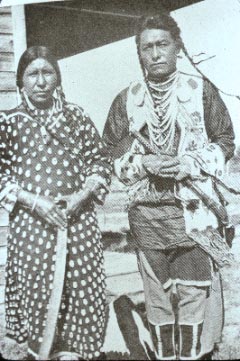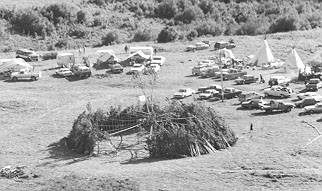Plains Study Guide
 |
|
Crow Couple
|
The materials on this page are intended for use by students enrolled in
ANTH 329 North American Indians. This page and its references are periodically up-dated.
Reading Assignments
Gill 1982: 27-29, 79-80, 97-101, and 161-173, and review 59-81
Oswalt and Neely 1999:175-211
Suggested Video
Wisconsin Powwow and Naamikaaged: Dancer for the People, Smithsonian
Folkways.
Cree Hunters, PBS Video.
To a discussion of:
Crow Social Organization and Kinship Terms
Overview
The primary focus of this section will be on the Crow of Montana, a representative of
the Plains culture area. Additional references will be made to the Arapaho, Blood,
Cheyenne, Kiowa, Lakota and Mandan, along with the Beaver, a tribe of Alberta and the
Subarctic culture area. The Crow term for themselves is "Apsaalooke," meaning
"children of the large beaked bird," which is in likely reference to the raven.

|
| "Big Lodge or Elder Brother" - Crow Sun
Dance Lodge - 1993 - and "Younger Brother" |
The Plains culture area encompasses the vast region between the Rocky Mountains in the
west and the Mississippi River to the east, from southern Alberta, Saskatchewan and
Manitoba, Canada in the north and the Rio Grande River and Texas in the south.
The peoples of the Plains were divided into two distinct types. There were societies,
like the Hidatsa and Mandan, who pursued a sedentary way of life, living in earthen lodges
and growing maize and beans. Political and spiritual power were typically acquired through
inheritance. In contrast, there were societies, like the Blackfeet, Cheyenne, Crow and
Lakota, who traveled by horse in a seasonal round with the buffalo, and lived in tipis.
These are peoples who gained and expressed their spiritual prowess in the vision quest and
Sun Dance, their military prowess in counting coup on an enemy, and their political
prowess as a chief through achieved deeds.
Study Guide Questions
- After considering some of the ways in which it is represented and expressed, discuss the
meaning and significance of the "wagon wheel."
- Discuss the various influences the introduction of the horse had on Crow society.
- Describe the Crow Tobacco Society and its ceremonialism.
- Compare the Crow Sun Dance of pre-1875 with that of the 1990s. How are they similar and
how are they different?
- Consider the "life-cycle" of a Crow.
- Who are the "berdaches?"
- Discuss the Dawes Act, also known as the Allotment Act. After discussing its general
provisions, consider the consequences of the Dawes Act, along with leasing practices,
among Crow.
- Discuss the character and significance of "medicine" (as presented from a Sun
Dance perspective). What are the ways "medicine" can be acquired? Discuss some
of the applications of "medicine." How does it influence peoples' lives?
Discuss the efficacy of "medicine." From the perspective of the Indian, how and
why does it work?
- Discuss the role and symbolism of “blood” and sacrifice as in the example of the Pawnee Morning Star ritual.
- Discuss the ritual processes and purposes associated with "fasting" (vision
questing) and the contemporary Sun Dance. How are they similar and different?
- Discuss the persistence of the sweat lodge, Sun Dance, vision quest and pipe among the
Plains peoples. In the context of Euro-American acculturation and assimilation, why have
these ceremonies persisted? In your discussion, also consider the persistence of Crow
"traditional culture."
- What is a "hand-game?"
- What is the general significance of the tipi and the Blackfoot Otter Lodge in
particular?
- What is a "pow wow" and discuss why people participate as dancers, singers,
and audience members.
- Discuss the nature of Crow kinship and, in particular, the role of the biilapxe,
or "clan uncles." Who are they and why are they so important for the Crow?
- What is a "give-away" and what is its significance?
- Discuss the nature and importance of traditional warfare among the Crow.
- What forms of "traditional" Crow culture have
persisted into contemporary times, and offer an explanation on why they have persisted.
Return to Top
You are currently viewing http://www.webpages.uidaho.edu/~rfrey/329plainsstudy.htm
To return to Frey's Home Page
To return to the University of Idaho Home Page
Page manager: rfrey@uidaho.edu



